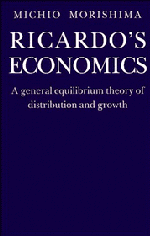9 - Towards an anti-Say's law regime
Published online by Cambridge University Press: 01 June 2011
Summary
1 During the nineteenth century Ricardo occupied a position in the world of economics analogous to that held by Keynes today. A considerable number of economists were still discussing his ideas several decades after his death, and his methods – namely the eliciting of laws and theorems deductively and purely logically on the basis of strict abstract concepts and definitions – continued to prevail among them. His verbal–logical economics and numerical examples were further refined by Marx who developed them into a numerical analysis based on a clearly defined mathematical model, albeit using hypothetical figures. Walras' general equilibrium theory can be seen as innovative of this trend, but it can also be seen as something which attempted to provide what in modern terminology could be called the microfoundations of Ricardian economics.
Marx's commendation of Ricardo's theories as scientific economics is well-known; Walras too, despite his critical stance towards Ricardo, respected him as ‘the founder of pure economics in England’ and devised three Ricardo-like laws as conclusions to his general equilibrium theory. However, as far as Say's law was concerned both Marx and Walras regarded Ricardo with critical eyes. The fact that most members of the classical school were optimistic regarding the establishment of full employment of labour, despite the categorization of economics as a dismal science, was in part a result of the belief placed in the existence of an automatic regulatory market mechanism, stemming from a fetishistic faith in Adam Smith's invisible hand.
- Type
- Chapter
- Information
- Ricardo's EconomicsA General Equilibrium Theory of Distribution and Growth, pp. 189 - 208Publisher: Cambridge University PressPrint publication year: 1989



